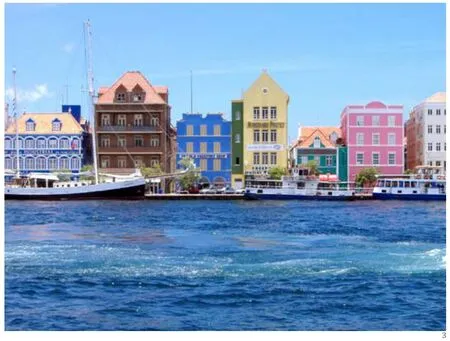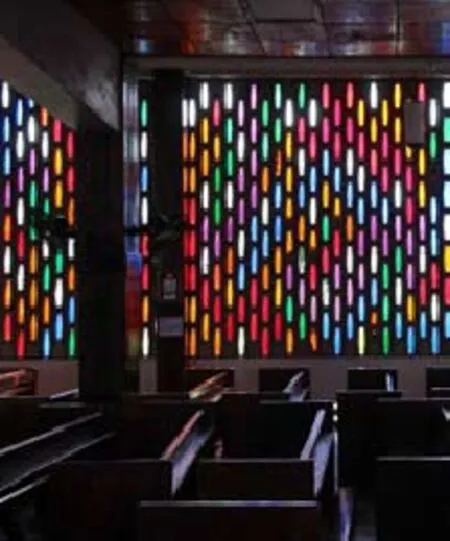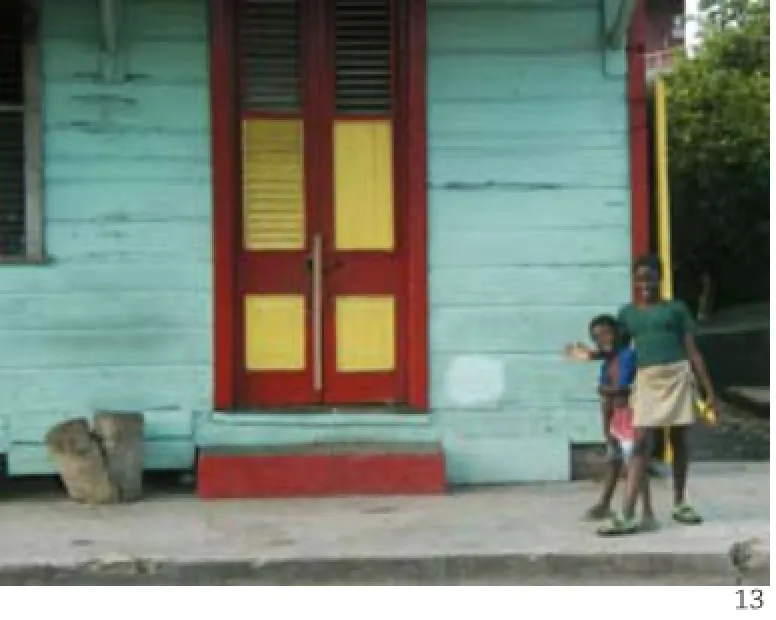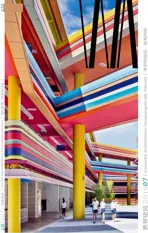加勒比建筑的色彩
2016-08-06斯蒂芬荷马StephanHomer
斯蒂芬·荷马/Stephan Homer
加勒比建筑的色彩
斯蒂芬·荷马/Stephan Homer
加勒比是一个具有多民族背景和深厚文化底蕴的群岛地区,坐落于大西洋和加勒比海之间,从迈阿密南部的岛屿起一直绵延到南美洲。这一地区的发展一贯具有多元化的特质,融汇了多种社会和商业活动,并由此产生了“加勒比风格建筑”这一专有名词及相关的建筑原型。加勒比风格建筑除了在视觉上夺人眼球之外,还具有特定的形式和立面做法标准。这些色彩明快的建筑物排列在群岛的城市、小镇和海岸线的各处,向人们彰显着这一地区的建筑特色,其建筑的历史则可以追溯至16世纪。加勒比建筑及其对于光鲜华美感受的追求不仅出于应对群岛炎热气候的目的,更已深植于这一地区的历史之中。
加勒比建筑,地方性,热带地区
加勒比地区在大多数人眼中都是一片精彩的岛屿,在那里,天堂以传统的建筑物的形式出现,形成大多数人孜孜追求的理想中轻松而远离尘嚣的生活环境。岛上充沛的阳光和放松的生活容易让人们忽视这里其实遍布着具有地方风格的独特建筑:这种建筑风格与为度假所用的表面功能并没有本质上的关系,而是体现在遍布建筑外墙和内部空间的鲜亮色彩之中。
加勒比建筑的演化受到了周边的诸多地区以及地理上所属的“热带建筑”的影响,最后则形成了自己的风范,成为综合了各种热带建筑风格和各时代建筑特点的大集合。历史上,这里的大部分岛国在迎来20世纪中期的独立之前(目前有部分地区仍受欧洲国家的管辖)都受到过欧洲殖民者的统治(例如西班牙、法国、荷兰和英国)。这些国家影响了加勒比地区城市的肌理,并留下了一些矗立至今的经典建筑。
但同时,当代的加勒比建筑也不仅仅受到过去的统治者们的影响。我们可以清楚地看到构成群岛的28个国家的各色独特人群对建筑的重要影响。这里的大多数国家原本属于聚居在岛上各地的原住民,这些原住民被认为有着亚洲血统,从亚洲和阿拉斯加地区通过白令海峡来到美洲,随着时间推移陆续地定居北美和南美各地,并进入到加勒比地区。这些印第安人散落在加勒比各处,甚至已经发现有些公元前3500年石器时代的人是从佛罗里达地区迁徙到西印度群岛来的。紧随着哥伦布的4艘大船航行到了西印度群岛,从16世纪初起,来自非洲的奴隶,来自亚洲的劳工,来自葡萄牙、法国(法国的克里奥尔人)、叙利亚、黎巴嫩及其他国家的移民开始陆续地进入加勒比地区。人口的导入带来了发达的工艺水平和群岛的商业繁荣,也开始在这些文明中融入本地的气候、文化和宗教特色。
这一地区的建筑和世界上其他热带地区的建筑有许多不同之处,但同样喜欢在立面和窗洞上使用各种色彩,以此模仿充沛的阳光和吹拂着海岸的凉爽的加勒比海风给人的感觉。这些鲜亮,甚至有时显得招摇而夸张的建筑物被视为加勒比建筑的标志。但同时,并没有哪一处地区的建筑可以被称为标准的加勒比建筑,因为每座岛屿都有其特有的建筑形式,而只有被同一个欧洲国家殖民过的地区才会在建筑上存在一些共性。这一地区建筑的共同点之一无疑是对气候要素的考虑,在这里建造建筑的基本需求是遮蔽阳光和雨水,这让建筑在形式上产生了一定的一致性。居住环境中对于室内与室外空间衔接的强调在其中起到了重要的作用,柱廊、廊道、露台、阳台等构件被广泛地应用在各地的建筑中。
诸如木材和砖之类的建材在早期的殖民建筑中被广泛使用,其中的部分材料是在一部分岛上就地生产的。这里的一些岛屿上有火山,而火山石正好可以作为建材来使用。而油漆和颜料的引进则打破了建筑过去只能使用自然色彩的情况,给用不同的色彩来表现非洲传统文化中的炙热情感提供了富有魅力的新方法。
在这里,对于色彩的使用不仅仅停留于装饰建筑表层的目的,同时也体现了人们对过去历经的磨难的纪念,也从文化上表达了对于祖辈居住之地的热爱。加勒比地区的本土建筑在一种和谐的多样性中共生、发展,尽管融合了多种风格和其他地区的装饰特点,最终则是形成了各自独一无二的风貌。
在过去,建造建筑在这一地区并不是一种专门的职业或者技能,在大多数时候是由工人借鉴欧洲既有的建筑设计,再在岛上复制而成的,这一过程常常掺杂着对原有建筑的误解。加勒比都市的城市肌理经常受到这种建筑形式的限制,而色彩的使用
Colour in Architecture in the Caribbean
司马蕾 译/Translated by SIMA Lei
The Caribbean is a multi-ethnic, culture-rich archipelago located between the Atlantic Ocean and the Caribbean Sea stretching from islands just south of Miami all the way to South America. The region has developed enormously; it continues to be a diverse zone of many social and commercial activities and is worthy of being identifed as the archetype of Caribbean Style Architecture. A fnite term is associated with a particular criterion for form and façade,but there is a lot more than meets the eye. Te bright array of buildings that populate the cities, towns, and beachfronts are just an introduction to the architecture of the region, and its architectural history dates as far back as the early 16th century. Te architecture of the Caribbean and its inclination toward the radiant and the ornate is deeply rooted in the history of the region and is not just a refection of the warmth of the islands.
Caribbean architecture, vernacular, tropicality
清华大学建筑学院
2016-6-21
The Caribbean is mostly viewed as the set of swashbuckling islands where paradise and traditional tectonics meet to create an idyllic, relaxed, and isolated life that most people seek. The abundance of sun and the relaxed mind-set of the people of the islands preclude the fact that there exists a cosmopolitan canopy of unique and inherited architectural styles that are not quintessentially associated with the attire worn at a beach resort, but with bright colours that line the walls of the exterior and interior spaces in the cities of the region.
Caribbean architecture has evolved alongside the architecture of many other regions and though geographically it ascribes to "Tropical Architecture," it has fashioned its way to become a hub where tropical architecture meets all styles and movements of the past and present. Historically, most of the islands were under rule of the then colonizers from Europe (Spain,France, the Netherlands, and Britain) prior to gaining independence in the mid-1900s (some of the islands are still under the jurisdiction of European states). Tese countries have infuenced the urban fabric of the Caribbean cities and there remain standing even today some remarkable works of architecture.
However, the remains of the then rulers are not the only influences that have driven contemporary Caribbean architecture. Instead, it can be asserted that the unique cosmopolitan fabric of the people who have graced the shores of these twenty-eight countries play an important role. Most of the islands were originally inhabited by settlements of people presumably of Asian backgrounds, who via Asia and Alaska, now referred to as the Bering Strait, over time settled in North and South America and then migrated to the Caribbean. Tese Amerindians were scattered in many locations and a few people from even the Stone Age, as early as 3500 BC, have been traced to migrate from Florida to the West Indies. Post Christopher Columbus's four voyages to the West Indies on the cusp of and in the early 16th century, there was an influx of African slaves,indentured laborers from Asia, immigrants from Portugal, France (French Creole), Syria, Lebanon,and several other countries entering the Caribbean over the years. Tis led to the blossoming of fantastic craftsmanship and splendorous design throughout the islands, which were adapted to suit the climate,cultures, and religions that coexisted on the islands.
Te region varies a lot from its tropical counterparts around the world, but the commonality that exists among all of them is the use of colour on facades and fenestrations to mimic the rich abundance of sunlight and cool Caribbean breezes that hit the shores of the islands. These bright and sometimes outrageously unapologetic buildings are the hallmark of what is considered Caribbean architecture. However, no architecture in the region can be specifcally labeled as Caribbean Architecture as each island has persistent architectural styles and only those colonized by the same European countries show some similarities. One common thread, however, is undoubtedly climatic considerations, which led to uniformity in the region for the basic requirement of shelter from the sun and rain. A strong connection to the outdoors from the interior spaces is evident in the design of the living environment, and features such as porches, galleries,verandas, and balconies are seen throughout.又受到使用材料的限制,但形成的建筑群却仍然能给人以庄严的感觉。


3 威廉斯塔德港,库拉索岛/Willemstad Harbour, Curacao(摄影/Photo: Stephan Homer)
4.5 昆斯皇家大学,特立尼达和多巴哥/Queens Royal College,Trinidad and Tobago
6.7 西印度群岛大学建筑学研究生院/Graduate School of Architecture,University of the West Indies, 设计/Designed by : Gillespie and Partners
(4-7摄影/Photos: Stephen Jameson)

8 刘易斯宅/Lewis House, 设计/Designed by Jamal Lewis(摄影/Photo: Lumis Photography)
9 西印度群岛大学圣奥古斯丁校区达嘎会堂/St. Augustine Campus Daaga Auditorium, University of the West Indies,设计/Designed by : Gillespie and Partners

而在进入21世纪后,这些乡土建筑之间开始穿插出现一部分当代建筑,形成带有过去建筑形制、却用现代技术和材料建造的现代乡土建筑。这种当代加勒比建筑通过几代国外与本土建筑师的共同努力,形成了这一地区在建筑上的新标准。现代主义思潮带来了喜用白色粉墙的审美倾向,这也帮助建筑突显此地阳光的炙热,形成建筑立面和室内空间中强烈的光影效果,而搭配的一抹色彩则为空间带来了空灵的感受(如巴拉干所言)。
但同时,当代建筑中也用了一些不是那么现代主义的手法来强调建筑的特色,使之更好地融入周边的环境。有时候,丰富的色彩被过于随意地使用在建筑上,看上去如同膏药,并有模仿别的建筑之嫌。但在大多数情况下,建筑则刚好成为了彰显个人品味和观念的理想媒介,被用来表现加勒比多民族的背景之下形成的各种文化风俗。
多样的文化和与之相关的节日让色彩也有很多机会在城市的街道景观中得以表现。例如Phagwa节是印第安庆祝春天的节日,色彩在其中被用来表现印度神话。这些由我们的印第安祖先带到这片海岸的节日今天已经成为了部分岛屿上的重要文化盛典。特里尼达和多巴哥的狂欢节(现在也成为了许多其他岛上文化的一部分)可以追溯到18世纪后期法国人在四旬节斋戒期间举行的化装舞会,当时,不能参加舞会的奴隶们模仿并形成了他们自己称之为“Canboulay” (在法国戛纳方言中意为燃烧的藤条)的庆祝活动。这一习俗在今天演变成了城市街道上色彩丰富、艺术形式独特而华丽的盛大化装游行。这两种文化节日都是当地人深厚文化底蕴的象征,也对建筑和周边环境中的色彩使用起到了重要作用,在特里尼达和多巴哥地区尤其如此。
在文化和传统之外,让使用者能加强空间体验质量的综合需求也是在这一地区使用色彩的原因之一。人们在室内和室外的建筑中的体验有时候是短暂的,但和其他各种短暂的体验一起,却能形成较具庄严性的感受。
在阿鲁巴和库拉索岛,街道景观就像一大片棉花糖,万花筒般的建筑连成一片,互相挤在一起不留一点空隙。需要透气的建筑则让空气能从自身的前后通过。这些岛受到了强烈的荷兰传统的影响,现在仍然是欧洲国家的附属地区。库拉索的建筑群描绘出荷兰殖民时期的17与18世纪阿姆斯特丹传统街道的风情。而建筑明亮的色彩却源自炎热而有清风吹拂的加勒比气候,这种建筑意向在荷兰本土并不存在。同时,这些建筑也融合了热带建筑的装饰风格以及加勒比建筑中常见的露台、格栅、柱廊等形式。当年的这些影响形成了该地区建筑早期的“全球地域一体化”特征,而现在的许多城市仍然承袭着一个世纪前的这种建筑风格和感觉。
加勒比地区长期被建设、装点为展现如画般的美丽建筑和能快速逃离现代生活喧嚣的场所。随着时间推移,用现代材料来复制传统乡土建筑的做法已经被发现有许多缺点,也造成了今天建筑风格的多样性。这一地区的每个国家都有自己的乡土风格,每种建筑元素都有符合当地特点的独特性,例如华丽的装饰花纹、格栅百叶窗(德梅拉拉窗),高耸的屋顶(屋脊和山墙)攒尖和围绕建筑外沿、为了遮阳和降低室内温度而设的柱廊等。这些建筑元素不仅具有装饰作用,也是展现个性品味和风格的载体。在许多情况下,这些建筑构件都是白色的,而建筑的立面则作为对比,被涂上绚丽的色彩,在另一些情况下则正好相反。
不言而喻,加勒比地区属于热带气候,其建筑也不可避免地遵循热带建筑的基本设计原理,但这一地区较少像其他一些地区一样因为这种气候而闻名(例如泰国、印度尼西亚等),反而更因为当地的建筑而出名。这里的岛屿不仅是度假胜地,也已经成为了现代化的大都会,具有风貌独特的市中心区、金融中心区,并作为具有观光、旅游、商业、艺术、文化历史和现代建筑价值的世界性群岛区而受到全球的关注。而色彩作为加勒比建筑中的重要要素,从形式上表现了大海、阳光和蓝天,体现出岛国的休闲氛围,也反映了这一地区丰富的文化内涵。
Materials such as wood and brick were prominent in the early colonial buildings and, in some cases, were manufactured locally on some of the islands. Some islands are known for their volcanoes and hence volcanic rock is used as part of the material palette. Te introduction of paint and pigments to the region muted the natural hues used earlier; these offered alluring new ways to express the efervescence of African traditions through the various colours that could be generated.
Te common denominator, the use of colour, is not just skin deep, but has emerged as a symbol of the hardships that the people have endured in the past and as a cultural expression of the places from where their forefathers once hailed. A symbiotic growth of harmony in diversity, the vernacular architecture of the Caribbean tries to be nothing other than itself despite the fusion of various styles and ornaments of other regions.
In the past, architecture neither was practiced as a profession nor was it a skill developed in the region; it was left to the workman who had to oftentimes use designs of buildings that existed in Europe and recreate them on the islands, which gave room for misinterpretations. As the urban fabric of the Caribbean cities developed, so too did the styles. Although the choice of materials often limited the colour palette available, it did not hinder the sublimity that resulted at the end of the day.
Fast forward to the 21st century, there now exist nestled amid the vernacular buildings, sets of contemporary works that claim to be modern vernacular with attributes of the past, designed and constructed using modern techniques and materials. Contemporary Caribbean architecture has been fashioned by several generations of architects both foreign and domestic, who have set new standards by which the region is judged architecturally.With the advent of modernism, there has been a proclivity for whitewashed buildings, which helps in accentuating the harsh sun and the play of shadow and light silhouettes on the facades and interior spaces, with a hint of colour to bring about an ethereal feel to these spaces (à la Barragan).
Then again, the not-so-modernist approach is considered to portray uniqueness and transform the architecture into objects that vindicate themselves as part of the context. The abundant use of colour can be deemed as pastiche, but only when arbitrarily placed like plasters on sores. The multi-ethnic background of the majority of the Caribbean people is portrayed in various ways; architecture happens to be just one medium that is symbolic of personal tastes and ideals.
The diverse cultures and associated festivals offer several ways in which colour is expressed in the streetscapes of the cities. The festival of Phagwa, which is the Indian celebration of spring, is known for its use of colour as part of the festivities,according to Hindu mythology. A celebration brought to the region's shores by Indian ancestors is today an integral part of the culture of some of the islands. Te carnival held in Trinidad and Tobago (now a part of the culture of many other islands) is an offshoot of the late eighteenth-century French masquerade balls held during the fasting period of Lent. It was adopted by slaves who were not able to partake in it and hence formed their own celebration called "Canboulay" (from the French Cannes "brulees" meaning "burning cane"). Te result of this today is a plethora of masquerade costumes worn by people parading the streets of the city displaying a riot of colours and splendor combining in a unique art form. These two cultural festivals embody the richness of the culture of the people and play a major part in the architecture and use of colour, especially in Trinidad and Tobago.
Culture and traditions are not the only rationale for the use of colour in the region; the use of colour also derives from the systemic need to enhance the experiential quality of spaces for the occupants. Architecture, both interior and exterior, is sometimes an ephemeral experience and capitalizing on other evanescent experiences has often led to majestic representation.
In the islands of Aruba and Curacao, the streetscape is like a field of cotton candy, lined with a kaleidoscope of buildings jutting against one another with no room to breathe. However, who needs room to breathe between buildings when the view to the front is breathtaking! Tese islands possess a strong Dutch history and influence and are still colonies of the European state. Curacao's covey of buildings depicts traditional streets lining Dutch colonial buildings of 17th and 18th century Amsterdam. The bright colours, however, were adapted to the warm, breezy Caribbean climate, a scene unprecedented on the mainland. Te buildings themselves were altered with typical features inherent in Caribbean structures such as verandas,porches, and shutters. Back then, these influences formed the early periods of "glocalization" in architecture for the region, and the many cities that exist today still bear the style and feel of the past century.
The Caribbean as a region has long been explored as a site for picturesque architecture and as a quick getaway from the hustle and bustle of modern life. Over time, the adaptation of modern materials to recreate traditional vernaculars has seen many shortcomings leading to variations in the styles seen today. While every country in the region has its own vernacular, there are elements that are deemed to be quintessentially unique to the region, such as ornate fret work, louvered shutters(Demerara windows) Jalousies, high-pitched roofs (hips and gables), fnials, and porches that wrap the exterior to help keep the interior spaces shaded and cool. Tese elements not merely used for ornamental purposes but also as a canvas to express one's personal taste and style. In many instances, these are painted white, while the facade of the building,in contrast, is painted in a variety of colours; in some cases, the opposite is done.
Although the Caribbean region experiences a tropical climate and the buildings adhere to the basic principles of tropical architecture, the region is less renowned than its climatic counterparts (Thailand, Indonesia, etc.); its architecture too is largely different from that of its counterparts. The islands are no longer just vacation spots; they have also grown to become modern metropoles that are unique urban centers, financial hubs, and a cosmopolitan archipelago boasting of great scenery,tourism, commercial activities, arts, culture, and historic and modern architecture deserving global attention. Colour is an overarching principle in Caribbean architecture and is purely a form of expression of the relaxed mood of the islands that mimic the sea, sun, and the blue skies and the rich cultures that exist within.


10 圣保罗国教教堂,圣费尔南多,特立尼达和多巴哥/St.
Pauls Anglican Church, San Fernando, Trinidad and Tobago
(9,10摄影/Photos: Stephen Jameson)
11 乔治·布朗宅,昆斯公园,萨凡那南部,特立尼达和多
巴哥/George Brown House, Queens Park Savannah South,
Trinidad and Tobago(摄影/Photo: Stephan Homer)
12 建筑师工作室,圣卢西亚/Architects Studio, St. Lucia, 设计/
Designed by: Melon(摄影/Photo: Lumis Photography)
13 西班牙港住宅/House in Port of Spain(摄影/Photo:
Stephen Jameson)
